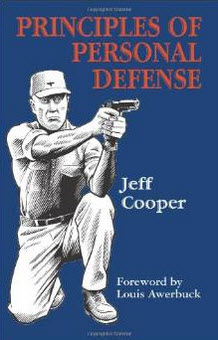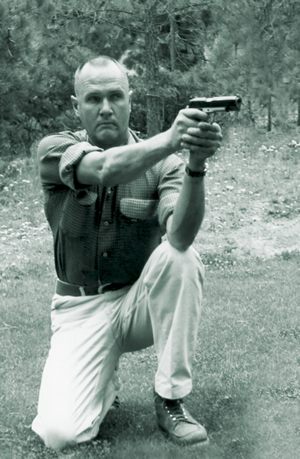
Principles of Personal Defense
May 17, 2015
“Combat is an unusual experience for most of us, but then emergencies of any kind always are. However, combat does occur, and any fully educated person knows this and prepares for it. Despite what we may hear, combat is not the characteristic of any particular occupation or situation. It may come to a policeman, but it may just as probably come to a barber, a broker or a biologist. Accepting this is the first step in physical security. No one can solve any problem of which he is not aware.”
Jeff Cooper, “The Combat Mindset” in American Handgunner Annual, 1986
“If you find yourself in a fair fight, your tactics suck.”
Jeff Cooper
 My politics are neither conservative or liberal.
My politics are neither conservative or liberal.
I don’t really agree with any party or philosophy 100% and I reserve the right to be inconsistent. As Emerson said, “A foolish consistency is the hobgoblin of little minds.”
But I must admit to often finding myself agreeing with some pretty conservative (even extremely conservative) thinkers on issues of personal protection .
While I am of two minds over how we treat criminals in the U.S. and about what sort of laws might better manage crime and reduce recidivism (relapse into crime) more inexpensively and without warehousing a big chunk of the population , I am crystal clear in my feelings on personal confrontation with crime or violence.
I’ve had my own small-scale run ins with violence. Lots of ass kickings as a kid (I was kind of a wise ass). I grew up in a blue collar family and fights were part of life. I brushed up against criminal violence a little as a young man, at the most bottom rungs of it, but I saw what was going to happen with those guys.
I’m also a student of history and I’ve studied both war and crime specifically.
Where wars break out, civilization breaks down and people are forced to rely on their own local capabilities to survive and avoid becoming casualties or victims. The worst in people comes to the surface and ordinary people are freed to express their most anti-social instincts.
Some people don’t need a war to let loose. The True Crime books are full of stories of people encountering the wrong person or persons at the wrong time and suffering horribly. We’re not just talking about the crazy (and rare) fringes here — its all on a continuum.
This knowledge has made me a little bit of a survivalist. Enough to spend a lot of time learning to fight. Of course there are other reasons, but that’s a big one. I have a very strong aversion to being a victim.
I don’t think you can rely on the police. There are not enough of them. And now and then, they are part of the problem. You can only be 100% sure of yourself and (hopefully) your friends and loved ones.
If you look at the history of crime, social unrest, and war, there are many incidents in which good people ran into the “bad” people and suffered very badly as a result. Names like Charlie Starkweather and the Manson Family and Ted Bundy and Edmund Kemper immediately come to mind. And events like the rise of the Fascists in Europe in the 1930s or the riots in the U.S. in L.A.
These events are rare but they happen. Shit will occasionally hit the fan and you might find yourself in the wrong place at the wrong time.
I don’t really take these concerns very far. I don’t have a bunker or an assault rifle. But my goal is always to be somewhat prepared. I don’t carry a gun or own a rifle but I know how to use them. I don’t (usually) carry a knife but I have some and I keep them sharp and am modestly competent in their use as a weapon.
This brings us to Jeff Cooper and his little “book,” Principles of Personal Defense . Its a very small book, only about 20 pages.
But it packs a punch. He says a lot of extremely important things in that small space that most people need to hear.
Cooper graduated from Stanford University and then took a commission in the Marines (Semper Fi!) during World War II. He was stationed on on the USS Pennsylvania in the Pacific. He also fought in Korea and left the service a Colonel.
In the 60s and 70s, he was a history teacher.
In 1976, Cooper founded the American Pistol Institute (later to become the Gunsite Training Center ), where he instructed cops and soldiers (as well as civilians) handgun and rifle shooting skills. While there, he developed and taught what is now called the “modern technique” for shooting a handgun (pretty much the agreed upon most effective way to do it).
He was a man of strong opinions. He actually reminds me of many of my male relatives. There is a lot of that no-nonsense Yankee grit in his writings, plus some harshness and a grim humor. In fact, he has been described as an ” unabashed racist, misogynist, Islamophobe, and homophobe.” So there you go. But it when it came to understanding how to deal with violence when it showed up on your doorstep, I think he had some correct ideas and he communicated them clearly.
In 1989, Paladin Press published Cooper’s little book on the subject of “individual conduct in lethal confrontation,” in which he teaches that the most important element in a “lethal confrontation” is the mindset .
 As we find in Wing Chun teachings, Cooper has realized that the “situations are numberless and specific recommendations cannot be made to cover them all.” So he describes the necessary
principles
or
qualities
which must be cultivated
:
Alertness, Decisiveness, Aggressiveness, Speed, Coolness (or Precision), Ruthlessness, and Surprise.
As we find in Wing Chun teachings, Cooper has realized that the “situations are numberless and specific recommendations cannot be made to cover them all.” So he describes the necessary
principles
or
qualities
which must be cultivated
:
Alertness, Decisiveness, Aggressiveness, Speed, Coolness (or Precision), Ruthlessness, and Surprise.
“When you suddenly realize that those men, right there, are armed and prepared to kill you, there will probably be a sudden sinking sensation into the pit of the stomach. The antidote for this hollow feeling is anger.”
Jeff Cooper
He devotes a few pages in his book to each principle and the sum idea is that we must instill in ourselves triggers which will escalate our state of awareness and preparedness for violence and that when violence arrives, we must recognize it and our response must be a violent and relentless counterattack.
Elsewhere, he developed a Color Code which he used at his Gunsite school to try and communicate an understanding of the general mindsets of human beings and the idea that we must be prepared to quickly shift to prepackaged states of readiness.
From Wikipedia :
“Considering the principles of personal defense, we have long since come up with the color code. This has met with surprising success in debriefings throughout the world. The color code, as we preach it, runs white, yellow, orange, and red, and is a means of setting one’s mind into the proper condition when exercising lethal violence … your combat mind-set is not dictated by the amount of danger to which you are exposed at the time. Your combat mind-set is properly dictated by the state of mind you think appropriate to the situation.
You may be in deadly danger at all times, regardless of what the Defense Department tells you. The color code which influences you does depend upon the willingness you have to jump a psychological barrier against taking irrevocable action.
He further simplified things in 2005:
“In White you are unprepared and unready to take lethal action. If you are attacked in White you will probably die unless your adversary is totally inept.
In Yellow you bring yourself to the understanding that your life may be in danger and that you may have to do something about it.
In Orange you have determined upon a specific adversary and are prepared to take action which may result in his death, but you are not in a lethal mode.
In Red you are in a lethal mode and will shoot if circumstances warrant.”
I think these ideas are absolutely crucial to consider as part of your overall approach to martial arts.
For shoot, substitute attack .
The Wing Chun songs say: “First Courage, then Power, then Skill.”
Why is courage first?
Because we are walking around in life half-awake most of the time. Violence is the furthest thing from our minds. But in real life, there is no Jaws music to warn you about an impending lethal encounter. Or maybe there is, and we call it intuition or a feeling, but we will most likely ignore it, and then violence will suddenly be upon us.
In most cases, we will have 20-30 years of tranquility and safety and then we will suddenly find ourselves victimized. If we stand there dazed and pleading for sanity, we may find ourselves mowed down. This has become a joke in horror and sci-fi movies. The true believer in the decency of the universe tries to reason with the monster and pulls back a bloody stump.
It is crucially important to have considered the ethical and tactical question of when we will be willing to pull the trigger on our training. When do you step up to another human being and literally smash their face in with the fists you’ve hardened on the wall bag for the last many years? There is a gap between normal life and this combat reality.
Your escalation from white to yellow to orange to red may all need to occur in a tenth of a second, from the bump in a bar against the wrong person to the angry shove to the deflection to the sudden appearance of a knife to the bloody screaming chaos of a life and death fight. Best to get these things clear in your mind in advance, so you can act with a grim authority in the service of your own survival and survival of your loved ones.